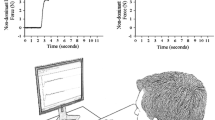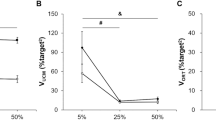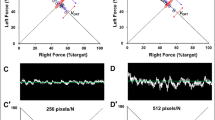Abstract
The effect of the intermittency of visual information in the bimanual coordination of an isometric force coordination task was investigated as a function of criterion force level. Eight levels of visual information intermittency (.2–25.6 Hz) were used in blocked fashion at each force level. Participants were required to produce a constant force output matching as accurately as possible the criterion force target. The results showed that performance improved as the intermittency of visual information was reduced—this effect being a function of force level. The distribution of the relative phase through the trial revealed a preference for the two hands to be coupled together (in-phase) at the slower rates of visual presentation (~.2 Hz). However, as the rate of visual feedback was increased (up to ~25.6 Hz), there was a transition to predominantly a negative correlation pattern (anti-phase). The pattern of bimanual coordination in this isometric tracking task is driven by the availability of information for error correction and the interactive influence of perceptual–motor constraints.





Similar content being viewed by others
References
Athreya DN, Van Orden G, Riley MA (2012) Feedback about isometric force production yields more random variations. Neurosci Lett 513:37–41. doi:10.1016/j.neulet.2012.02.002
Baweja HS, Kennedy DM, Vu J, Vaillancourt DE, Christou EA (2010) Greater amount of visual feedback decreases force variability by reducing force oscillations from 0–1 and 3–7 Hz. Eur J Appl Physiol 108:935–943. doi:10.1007/s00421-009-1301-5
Debaere F, Swinnen SP, Béatse E, Sunaert S, Van Hecke P, Duysens J (2001) Brain areas involved in interlimb coordination: a distributed network. NeuroImage 14:947–958. doi:10.1006/nimg.2001.0892
Debaere F, Wenderoth N, Sunaert S, Van Hecke P, Swinnen SP (2003) Internal vs external generation of movements: differential neural pathways involved in bimanual coordination performed in the presence or absence of augmented bisual feedback. NeuroImage 19:764–776. doi:10.1016/S1053-8119(03)00148-4
Deutsch KM, Newell KM (2004) Changes in the structure of children’s isometric force variability with practice. J Exp Child Psychol 88:319–333. doi:10.1016/j.jecp.2004.04.003
Hong SL, Newell KM (2008) Entropy compensation in human motor adaptation. Chaos 18:013108. doi:10.1063/1.2838854
Hong SL, Lee MH, Newell KM (2007) Magnitude and structure of isometric force variability: mechanical and neurophysiological influences. Mot Control 11:119–135
Hong SL, Brown AJ, Newell KM (2008) Compensatory properties of visual information in the control of isometric force. Percept Psychophys 70:306–313. doi:10.3758/pp.70.2.306
Hu X, Loncharich M, Newell KM (2011) Visual information interacts with neuromuscular factors in the coordination of bimanual isometric force. Exp Brain Res 209:129–138. doi:10.1007/s00221-010-2528-4
Jagacinski RJ, Flach JM (2003) Control theory for humans: Quantitative approaches to modeling performance. Erlbaum, Mahwah
Jones RD (2000) Measurement of sensory-motor control performance capacities: Tracking tasks. In: Bronzino JD (ed) The biomedical engineering handbook, 2nd edn. CRC Press, Boca Raton, pp 149–161
Kelso JAS (1994) Elementary coordination dynamics. In: Swinnen SP, Heuer H, Massion J, Casaer P (eds) Interlimb coordination: neural, dynamical, and cognitive constraints. Academic Press, San Diego, pp 301–318
Kelso JAS (1995) Dynamic patterns: the self organization of brain and behavior. The MIT Press, Cambridge
Kelso JAS, Engstrøm DA (2006) The complementary nature. The MIT Press, Cambridge
Kennedy DM, Boyle JB, Rhee J, Shea CH (2014a) Rhythmical bimanual force production: homologous and non-homologous muscles. Exp Brain Res 233:181–195. doi:10.1007/s00221-014-4102-y
Kennedy DM, Boyle JB, Wang C, Shea CH (2014b) Bimanual force control: cooperation and interference? Psychol Res. doi:10.1007/s00426-014-0637-6
Kovacs AJ, Buchanan JJ, Shea CH (2010) Impossible is nothing: 5:3 and 4:3 multi-frequency bimanual coordination. Exp Brain Res 201:249–259
Lamb PF, Stöckl M (2014) On the use of continuous relative phase: review of current approaches and outline for new standard. Clin Biomech 29:484–493
Masumoto J, Inui N (2012) Effects of force levels on error compensation in periodic bimanual isometric force control. J Mot Behav 44:261–266. doi:10.1080/00222895.2012.690354
Mechsner F, Kerzel D, Knoblich G, Prinz W (2001) Perceptual basis of bimanual coordination. Nature 414:69–73. doi:10.1038/35102060
Morrison S, Newell KM (1998) Interlimb coordination as a function of isometric force output. J Mot Behav 30:323–342
Newell KM (1985) Coordination, control and skill. In: Goodman D, Wilberg RB, Franks IM (eds) Differing perspectives in motor learning, memory, and control. North-Holland, Amsterdam, pp 295–317
Newell KM, McDonald PV (1994) Information, coordination modes and control in a prehensile force task. Hum Mov Sci 13:375–391. doi:10.1016/0167-9457(94)90046-9
Newell KM, Studenka BE, Hu X (2014) Visual information in the coordination and control of isometric force. In: Hoffman RR, Hancock PA, Scerbo M, Parasuraman R, Szalma JL (eds) The Cambridge handbook of applied perception research. Cambridge University Press, Cambridge
Oda S, Moritani T (1994) Maximal isometric force and neural activity during bilateral and unilateral elbow flexion in humans. Eur J Appl Physiol 69:240–243
Poulton EC (1974) Tracking skill and manual control. Academic Press, New York
Ranganathan R, Newell KM (2008a) Motor synergies: feedback and error compensation within and between trials. Exp Brain Res 186:561–570. doi:10.1007/s00221-007-1259-7
Ranganathan R, Newell KM (2008b) Online feedback and the regulation of degrees of freedom in motor control. Hum Mov Sci 27:577–589. doi:10.1016/j.humov.2008.01.002
Richman JS, Moorman JR (2000) Physiological time-series analysis using approximate entropy and sample entropy. Am J Physiol Heart C 278:H2039–H2049
Rosenblum M, Kurths J (1998) Analysing synchronization phenomena from bivariate data by means of the Hilbert transform. In: Kantz H, Kurths J, Mayer-Kress G (eds) Nonlinear analysis of physiological data. Springer, Berlin Heidelberg, pp 91–99
Schmidt RC, Carello C, Turvey MT (1990) Phase-transitions and critical fluctuations in the visual coordination of rhythmic movements between people. J Exp Psychol Hum 16:227–247. doi:10.1037//0096-1523.16.2.227
Scholz JP, Kang N, Patterson D, Latash ML (2003) Uncontrolled manifold analysis of single trials during multi-finger force production by persons with and without Down syndrome. Exp Brain Res 153:45–58. doi:10.1007/s00221-003-1580-8
Shea CH, Buchanan JJ, Kennedy DM (2015) Perception and action influences on discrete and reciprocal bimanual coordination. Psychon Bull Rev. doi:10.3758/s13423-015-0915-3
Slifkin AB, Newell KM (1999) Noise, information transmission, and force variability. J Exp Psychol Hum Percept Perform 25:837–851
Slifkin AB, Newell KM (2000) Variability and noise in continuous force production. J Mot Behav 32:141–150
Sosnoff JJ, Newell KM (2005) Intermittent visual information and the multiple time scales of visual motor control of continuous isometric force production. Percept Psychophys 67:335–344
Sosnoff JJ, Newell KM (2006) Information processing limitations with aging in the visual scaling of isometric force. Exp Brain Res 170:423–432. doi:10.1007/s00221-005-0225-5
Studenka BE, King AC, Newell KM (2014) Differential time scales of change to learning frequency structures of isometric force tracking. J Exp Psychol Hum Percept Perform 40:1629–1640. doi:10.1037/a0037113
Swinnen SP, Wenderoth N (2004) Two hands, one brain: cognitive neuroscience of bimanual skill. Trends Cogn Sci 8:18–25. doi:10.1016/j.tics.2003.10.017
Swinnen SP, Dounskaia N, Levin O, Duysens J (2001) Constraints during bimanual coordination: the role of direction in relation to amplitude and force requirements. Behav Brain Res 123:201–218
Swinnen SP, Li Y, Wenderoth N, Byblow W, Stinear C, Dounskaia N, Wagemans J (2004) Perception-action coupling during bimanual coordination: the role of visual perception in the coalition of constraints that govern bimanual action. J Mot Behav 36:394–398. doi:10.1080/00222895.2004.11008005
Vaillancourt DE, Mayka MA, Corcos DM (2006) Intermittent visuomotor processing in the human cerebellum, cortex, and premotor cortex. J Neurophys 95:922–931
Wimmers RH, Beek PJ, van Wieringen PCW (1992) Phase-transitions in rhythmic tracking movements—a case of unilateral coupling. Hum Mov Sci 11:217–226. doi:10.1016/0167-9457(92)90062-G
Zanone PG, Kelso JAS (1992) Evolution of behavioral attractors with learning nonequilibrium phase transition. J Exp Psychol Hum Percept Perform 18:403–421
Author information
Authors and Affiliations
Corresponding author
Rights and permissions
About this article
Cite this article
Lafe, C.W., Pacheco, M.M. & Newell, K.M. Bimanual coordination and the intermittency of visual information in isometric force tracking. Exp Brain Res 234, 2025–2034 (2016). https://doi.org/10.1007/s00221-016-4606-8
Received:
Accepted:
Published:
Issue Date:
DOI: https://doi.org/10.1007/s00221-016-4606-8




